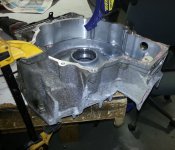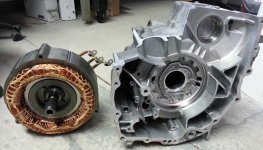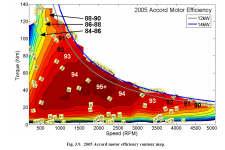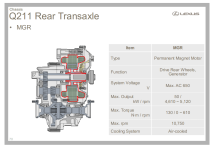Hi EP,
I started an electric conversion on my 2000 Porsche 911 about 18 months ago and I'm wondering whether to continue it, or not. This decision ultimately comes down to how useful the result will be for others, particularly those on this list that are hobbyists like me. Allow me to explain further:
I am a fan of electric-drive vehicles, whether hybrid, or electric, and I'm also somewhat cheap when it comes to things I can do myself. Last year, I completed my Electrical Engineering Ph.D. at University of Wisconsin - Madison, in what is arguably the best motors and drives program in the world and I definitely feel capable of pulling off this project, but work and other life activities have pulled me away from prioritizing this conversion project.
The conversion project plan was as follows:
1) remove blown engine and transmission, (sell transmission, part engine)
2) Install twin Toyota Highlander hybrid motors from two transmissions along with custom gearing/chain/sprocket to two rear wheels independently
3) Install 650V, 12kWh lithium polymer battery pack (leveraging my dealer account on HobbyKing) and CUSTOM battery management system (Active balancing and monitoring)
4) Install CUSTOM dual AC motor controller with resolver position feedback, 'black box' functionality and a few other general purpose inputs and outputs (fan control, oil pump, etc.)
5) hook it all up, debug the program, test failsafes, and then drive it.
6) eventually hook up a range-extending generator for more than 30 mile range.
As indicated above, this involved two custom projects, a BMS and a drive/controller. Personally, I think the idea of both of these is very cool as a hobbyist and I think (hope) some of you all do as well, but I need to hear this so that I know that if I get both of these custom projects together that someone beyond me could make use of them. The BMS project is further along (tested prototype, see madpowerlab.com for details) than the drive, which is sitting as an un-assembled circuit board and box of components. Like I said, I think these are cool projects and I'd like to see them live, but if it's just for me, I'm not sure I'll find the motivation to complete them.
Secondarily, if there is anyone local to the bay area that would like to lend a hand, that would be awesome. For some more background, I've included a list of specs for each below:
Controller:
dual 3-phase AC motor controller, uses semikron 150A, 1200V modules
Full galvanic or optical isolated gate drivers
Integrated 12V, 600W DC-DC converter fed from high voltage battery pack (650V nominal, but adjustable with design changes)
5 12V switched outputs for accessories
'black box' with accelerometer, rate gyro, and SD card (to record events if they occur, were an event could be a software fault or an actual vehicle crash)
State of completion:
Prototype design complete, hardware on hand, just need to put it together and test it.
Active Battery Management System (LiFe or LiPo):
8 Cell stackable slave boards
9 Cell master board with bluetooth or isolated data output
8 temperature and voltage mesurements
8 active 2-cell charge-balancers (balancers manage state of charge of each individual cell, capable of powering low capacity/performance cells by adjacent cells)
for more information, see madpowerlab.com
State of completion:
semi-tested prototype, on 5th revision
So, comments and suggestions welcome. Thanks!
I started an electric conversion on my 2000 Porsche 911 about 18 months ago and I'm wondering whether to continue it, or not. This decision ultimately comes down to how useful the result will be for others, particularly those on this list that are hobbyists like me. Allow me to explain further:
I am a fan of electric-drive vehicles, whether hybrid, or electric, and I'm also somewhat cheap when it comes to things I can do myself. Last year, I completed my Electrical Engineering Ph.D. at University of Wisconsin - Madison, in what is arguably the best motors and drives program in the world and I definitely feel capable of pulling off this project, but work and other life activities have pulled me away from prioritizing this conversion project.
The conversion project plan was as follows:
1) remove blown engine and transmission, (sell transmission, part engine)
2) Install twin Toyota Highlander hybrid motors from two transmissions along with custom gearing/chain/sprocket to two rear wheels independently
3) Install 650V, 12kWh lithium polymer battery pack (leveraging my dealer account on HobbyKing) and CUSTOM battery management system (Active balancing and monitoring)
4) Install CUSTOM dual AC motor controller with resolver position feedback, 'black box' functionality and a few other general purpose inputs and outputs (fan control, oil pump, etc.)
5) hook it all up, debug the program, test failsafes, and then drive it.
6) eventually hook up a range-extending generator for more than 30 mile range.
As indicated above, this involved two custom projects, a BMS and a drive/controller. Personally, I think the idea of both of these is very cool as a hobbyist and I think (hope) some of you all do as well, but I need to hear this so that I know that if I get both of these custom projects together that someone beyond me could make use of them. The BMS project is further along (tested prototype, see madpowerlab.com for details) than the drive, which is sitting as an un-assembled circuit board and box of components. Like I said, I think these are cool projects and I'd like to see them live, but if it's just for me, I'm not sure I'll find the motivation to complete them.
Secondarily, if there is anyone local to the bay area that would like to lend a hand, that would be awesome. For some more background, I've included a list of specs for each below:
Controller:
dual 3-phase AC motor controller, uses semikron 150A, 1200V modules
Full galvanic or optical isolated gate drivers
Integrated 12V, 600W DC-DC converter fed from high voltage battery pack (650V nominal, but adjustable with design changes)
5 12V switched outputs for accessories
'black box' with accelerometer, rate gyro, and SD card (to record events if they occur, were an event could be a software fault or an actual vehicle crash)
State of completion:
Prototype design complete, hardware on hand, just need to put it together and test it.
Active Battery Management System (LiFe or LiPo):
8 Cell stackable slave boards
9 Cell master board with bluetooth or isolated data output
8 temperature and voltage mesurements
8 active 2-cell charge-balancers (balancers manage state of charge of each individual cell, capable of powering low capacity/performance cells by adjacent cells)
for more information, see madpowerlab.com
State of completion:
semi-tested prototype, on 5th revision
So, comments and suggestions welcome. Thanks!













